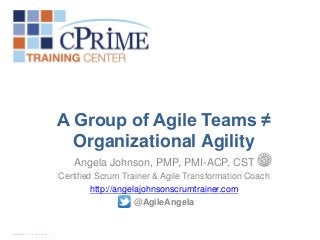
A Group of Agile Teams ≠ Organizational Agility
- 1. A Group of Agile Teams ≠ Organizational Agility Angela Johnson, PMP, PMI-ACP, CST Certified Scrum Trainer & Agile Transformation Coach http://angelajohnsonscrumtrainer.com @AgileAngela
- 2. Angela Johnson PMP, PMI-ACP, CST • 18+ years Information Technology - traditional SDLC and Scrum/Agile • Facilitator PMI-MN Agile Local Interest Group • Based in Minneapolis, MN
- 3. Why Agile? Any Agile Adoption should start out by asking, “Why do we want to use Agile”? Being “Agile” is not the Goal! Agile is about delivering Business Value
- 4. 2012 VersionOne State of Agile Survey
- 5. Organizational Agility “A group of agile teams does not an agile organization make…”
- 6. Organizational Agility “The new goal for the organization must be to delight the customer.” •“Making money” is not the goal •“Being agile” is not the goal. •“Working software” is not the goal •Agile, Scrum & working software are means to achieving the goal
- 7. Organizational Agility What is Organizational Agility? • The capacity of a company to rapidly change or adapt in response to changes in the market • A high degree of organizational agility can help a company to react successfully to the emergence of new competitors, the development of new industry-changing technologies, or sudden shifts in overall market conditions www.BusinessDictionary.com
- 8. Shared Vision or Current Reality? Adapted from The Fifth Discipline: The Art & Practice of the Learning Organization by Peter M. Senge
- 9. Shared Vision or Current Reality? Adapted from The Fifth Discipline: The Art & Practice of the Learning Organization by Peter M. Senge
- 15. Potential Obstacles New Quality Practices • Testers are part of the team • Tests drive coding • Testing a user story is done within an iteration – not after • Quality is not a role, a person or a department – it’s everyone’s job • Testing is not something performed by a “tester” • Test automation is critical to long-term effectiveness
- 16. Potential Obstacles Personnel Considerations • Focus is on Cross Functional Teams • Delivery is Value Based on the Customer • What support or training do our teams need to make the paradigm shift in collaboratively working in a cross functional way? • What happens to our individual incentives in asking people to work in teams? • What happens to our hiring practices in asking for cross functional behavior and skills? • What about career path considerations?
- 18. Realizing the Vision Use a Management or Organizational Backlog to Prioritize Next Steps
- 19. Shift in Leadership Characteristics • Inclusive, Collaborative • Flexible, Adaptive • Possibly-Oriented • Facilitative • Self-reflective • Courageous • Observant Adapted from Leadership Agility, Bill Joiner & Stephen Josephs and Action Inquiry, William Torbert
- 20. How Long Does this Take? It Depends… • Size of the Organization • Organization Culture • Flexibility and Adaptability • Commitment of Organization Leadership • Commitment to Automation
- 21. A Case Study • Privately held organization that provides contract and support services to a worldwide franchise • Moved from project structure to product structure enabling faster delivery of business value • Teams are empowered, co-located and high performing • Better alignment with the Business
- 22. 10 Reasons I Love My Job 3. Integrated teams. Product owner, QA, operations, infrastructure, developers – we’re all on the same team. We work together, and are committed to each other. There is opportunity for growth. Just one month in, I can already sense it. And many times I’ve already seen where wins are celebrated by the entire team, and mistakes are owned by the entire team. It’s awesome. http://silvanolte.com/blog/2013/02/09/10-reasons-i-love-my-job/
- 23. 10 Reasons I Love My Job 2. Agile. Weekly sprints. Sprint goals. The ceremonies. The daily meetings. The sprint planning. The sprint retrospectives. The sprint board. The stickies. Weekly deployments into Production. Having a clear sense of what our focus is this week. Commitment to the work at hand. Establishing a velocity and trusting in the team to perform. Similar to feeling at home with Apple products and OS X, I also feel incredibly at home in this environment. http://silvanolte.com/blog/2013/02/09/10-reasons-i-love-my-job/
- 24. 10 Reasons I Love My Job 1. People care. This is the most important thing to me. I work in an environment where people really care about what they do. Shades of gray, I acknowledge, between just being somewhere for the paycheck and having a passion for what you do. At my new workplace, I find that people care about what they do. To do well for their customer because it’s the right thing to do. Because there’s a sense of pride in doing good. I can get a paycheck anywhere. But I can only do what I do, and with the people I do it with, where I’m at right now. http://silvanolte.com/blog/2013/02/09/10-reasons-i-love-my-job/
- 25. A Case Study The CIO’s email to me in sharing the blog post: “One more thing. Check out this blog from one of our developers. I can die and go to CIO heaven now. Thanks for all you did to help us get to where we are.” http://silvanolte.com/blog/2013/02/09/10-reasons-i-love-my-job/
- 26. Questions
